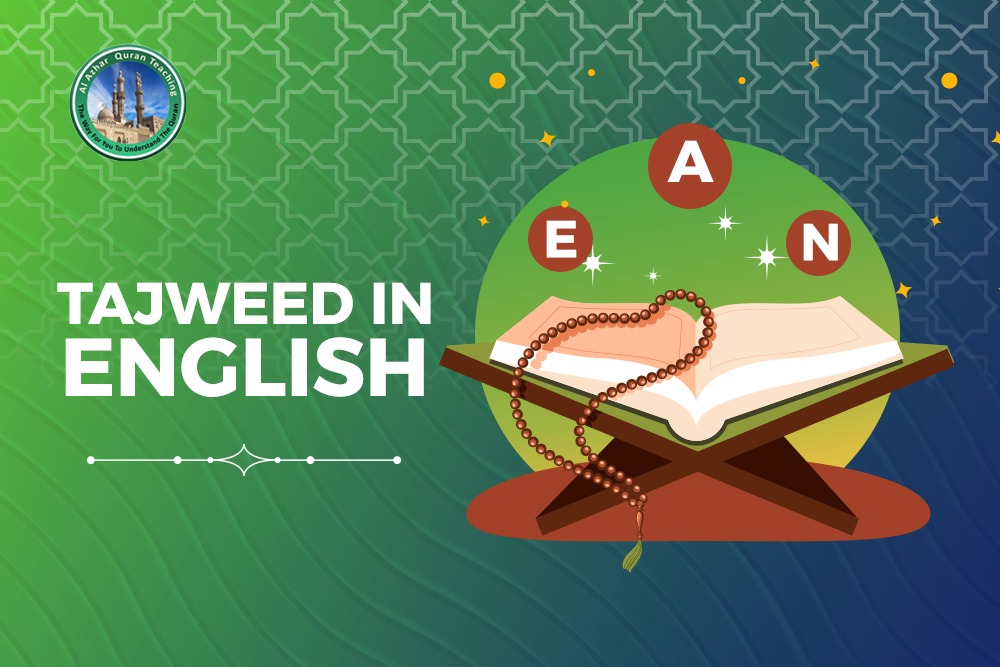Tajweed in English
What is Shaddah?
A Shaddah tends to remove the recurrence of the same letter in one word.
So, you can see in the example that Shaddah is formed by bringing together two of the same letter, the first one is sukoon (without vowel) and the second one with a vowel, it is recited with emphasis.
ربّْ = بَ بْ رَ
Rules of Noon and Meem Mushaddad
The way of pronouncing them
When the letters Noon (ن) or Meem (م) is Mushaddad That means it has a Shaddah on it like- نّ , مّ. It must be read with Ghunna (or Nasal sound) of 2 (beats) on it. It should not exceed the prolongation of 2 Harakah.
Both م, ن letters share the ghunnah (nazalisation) during articulation from the Nasal cavity or passage.
As I told earlier a letter with Shaddah consists of two letters, the first with sukoon and the second with Harakaat. The Sukoon letter merged with the other pronouncing them like one letter making a Shaddah.
Example
نِّ = نْ + نِ نُّ = نْ + نُ نَّ = نْ +نَ
إِنَّ = نَ + إِنْ ثُمَّ = مَ + ثُمْ لَمَّا = مَا + لَمْ
Here is an example of noon sukoon & gunnah: Yellow color is noon sukoon.
And of the people are some who say, “We believe in Allah and the Last Day,” but they are not believers. (Surah Baqarah)
In this aayah, there are two different with a shaddah on them. Each of them should be held for a period of time, equal to the other, elongating the sound with a ghunnah emitted from the nose.
Here is an example of meem sukoon & gunnah in yellow:
“Who believe in the unseen, establish prayer, and spend out of what We have provided for them.” (Surah Baqarah)
The next two aayaat there are three different that have a shaddah on them. They are in red. Each of them are held for a length of time, equal to each other with a ghunnah (nasalization) accompanying the lengthening.
As I’ve mentioned earlier, diacritics have the ability to change the entire meaning of a word/sentence. Let me tell you by giving examples-
Let’s look at the word:
دَرَسَ
darasa
Darasa means “he studied”. Now let’s add a shaddah to this word:
دَرَّسَ
dar-rasa
Darrasa means “he taught”. It seems simple, but big difference.
One more example.
The sentence:
صَبِيٌّ بَكى
bakaa sabiy-yun
This sentence means “a boy cried”.
Adding another two shaddah causes two things, letters alif and laam to be added making the boy an object being pointed to, and the meaning to change.
Note:
بَكَّى الصَّبِيُّ
bak-kaa al-sabiy-yu
Which means “(he) made the boy cry”.
There is some tricks of grammar too. So, now it is clear that not only do diacritics change the meaning of things, but so does the pronunciation of a letter.
The Ghunnah
Ghunnah: The ghunnah is a nasal sound that is come out from the nose. This is a required characteristic of the ن and م. In other words, hiding the voice of م or ن completely into the nose for a while is called Ghunnah The ghunnah cannot be separated from these two letters and is an inherent part of their getup. The ghunnah is not a letter but a particular feature of these two letters, but it has its own distinct place of articulation. It can be done in Meem Mushaddad or Noon Mushaddad, this will always be heavy and complete Ghunnah.
Examples for ghunnah noon mushadadah:
____________________
Examples of ghunnah meem mushaddadah :
____________________
In Tajweed, do remember shaddah + meem م, or noon ن = ghunnah.
Al –Qalqalah
What is Qalqalah?
Now_ow I’m_m Gonn_nna_aa tell you_ou about_ut Qalqalah_ah_ah
Sounds funny though!
Okay, Do you get it, echo! That I’m emphasizing on! Right.
Qalqalah is made by echo of sound articulation and echo. In general, the word means shaking/disturbance. In Tajweed, it means to vibrate the letter that has sukoon, without any corresponding movement of the mouth and jaw that is associated with voweled letters that have fat-ha, dammah, or kasra. Qalqalah tends to “shakes” to “echo” the letter without taking up the preceding or succeeding letter’s diacritic. Means vibration, it is the vibration of sound at the end of the pronunciation of a letter.
There are five letters in the Arabic alphabet that have the effets of Qalqalah. Those five letters are:
ج د ب ط ق
A thing to note: Qalqalah is only pronounced when the letter has the Sukoon sign or is assigned a sukoon because of stopping.
Wherever these 5 have sukoon, there is Qalqalah. Here is a list
حِیْمِ الرَّ الرَّحْمَنِ اللہِ بِسْمِ
قُلْ أَعُوذُ بِرَبِّ الْفَلَقِ ﴿١﴾ مِن شَرِّ مَا خَلَقَ ﴿٢﴾ وَمِن شَرِّ غَاسِقٍ إِذَا وَقَبَ ﴿٣﴾
وَمِن شَرِّ النَّفَّاثَاتِ فِي الْعُقَدِ ﴿٤﴾ وَمِن شَرِّ حَاسِدٍ إِذَا حَسَدَ ﴿٥﴾
Surah Falaq is the perfect and standard example of Qalqalah
Do you noticed that it is qalqalah that distinguishes ( ق ) from ( ك ), letter ( ط ) from ( ت ), and ( د ) from ( ض ).
There are three types of qalqalah.
Strong (Qalqalah Kubra)
Medium (Qalqalah Wusta)
Weak (Qalqalah Sughra)
Read about Tajweed Online Classes.
Strong
Qalqalah is prominent when we are stopping and therefore the qalqalah letter carries a shaddah thereon. This case happens for gifted sakoon only and since shaddah means doubling of the letter a robust qalqalah is articulated to representing this doubling. In surah Falaq you can see that Qalqalah ends at the last, which means strong Qalqualah. Such as – خَلَقَ, الْفَلَقِ, حَسَدَ, وَقَبَ etc. coloured in blue. I will suggest that you must listen to Surat Al-Falaq [113], Al-Masad [111], Al-Qiyaamah [75] for Practice and identifying Strong Qalqalah
حِیْمِ الرَّ الرَّحْمَنِ اللہِ بِسْمِ
﴿١﴾ ضَبْحًا وَالْعَادِيَاتِ
﴿٢﴾ قَدْحًا فَالْمُورِيَاتِ
﴿٣﴾ صُبْحًا فَالْمُغِيرَاتِ
﴿٤﴾ فَأَثَرْنَ بِهِ نَقْعًا
﴿٥﴾ جَمْعًا بِهِ فَوَسَطْنَ
﴾ ٦ ﴿ لَكَنُودٌ لِرَبِّهِ الْإِنْسَانَ إِنَّ
Medium
Qalqalah is medium once we are stopping on a qalqalah letter and it does not carry a shaddah. It doesn’t matter whether the letter has an original or presented sakoon. In the surah Adiyat, we can found the middle medium Qalqalah. Such as ضَبْحًا, قَدْحًا, صُبْحًا, etc. colored in blue.
حِیْمِ الرَّ الرَّحْمَنِ اللہِ بِسْمِ
الْقَارِعَةُ ( 1 )
الْقَارِعَةُ مَا ( 2 )
الْقَارِعَةُ مَا أَدْرَاكَ وَمَا ( 3 )
الْمَبْثُوثِ كَالْفَرَاشِ النَّاسُ يَكُونُ يَوْمَ ( 4 )
Weak
Qalqalah is weak when it’s within the middle of the recitation. Qalqalah letter is often within the middle of the word or at the top carrying an ingenious sakoon check in it. However, because the reciter goes to continue, a weak qalqalah takes place because the reciter quickly moves on to a subsequent letter. Such as- الْمَبْثُوثِ, أَدْرَاكَ, etc. colored in red.
Though you’ll get medium and weak Qalqalah throughout the holy Quran. But Surah Al-Qalam [68], Surah Al-Muzzamil [73] can be a good example of it.

